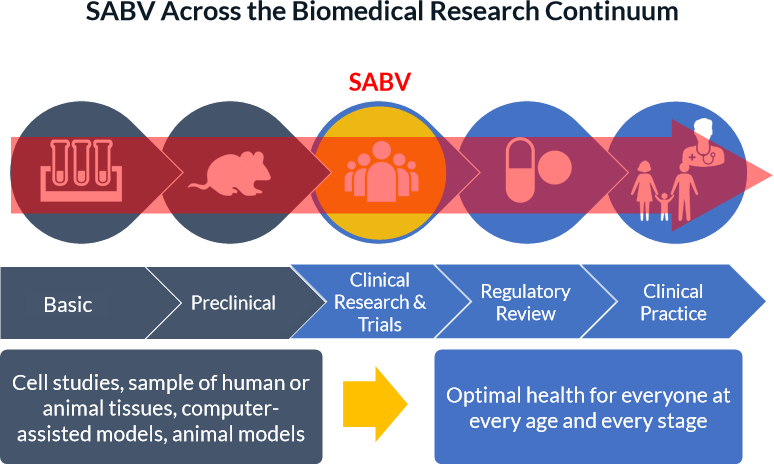2 Comments
Interest in sex and gender in research—and resources to help investigators—is growing. In the 5 years since NIH enacted its pioneering Policy on Sex as a Biological Variable (SABV) (see our progress report here), there has been a lot of activity, including increased attention on sex differences and influences and many questions and requests for assistance. I’m pleased to announce the NIH Office of Research on Women’s Health (ORWH) has issued two new courses, Sex as a Biological Variable: A Primer and Bench to Bedside: Integrating Sex and Gender to Improve Human Health, to our suite of free e-learning offerings.

Before discussing these e-learning opportunities, I would like to invite you to a related symposium where we will explore current gaps or barriers within different sectors of the biomedical research enterprise, introduce areas of scientific opportunity that the study of sex and gender presents, and underscore its impact on science and public health. Our Fifth Annual Vivian Pinn Symposium: Integrating Sex and Gender into Biomedical Research as a Path for Better Science and Innovation will be held virtually on May 11-12, 2021. Registration information can be found here. I look forward to seeing you at the symposium.
To enhance transparency, researchers should consider the potential influence of sex on the disease, condition, or phenomenon being studied, whether there is already a proven influence or not. Investigators should design research that studies both sexes whenever possible, collecting data in a way that allows for disaggregation of data by sex. Even when a study isn’t sufficiently powered to detect a sex-based difference in analysis, data can be reported separately for each sex, to facilitate meta-analyses and inform future studies.
Developed with funding support from ORWH, the NIH Office of the Director, and the National Institute of General Medical Sciences (NIGMS), one of the new e-learning courses, called the SABV primer, provides guidance for researchers seeking to enrich research by making SABV a routine part of it.
Jon R. Lorsch, Ph.D., Director of NIGMS, explains, “Despite being a central part of biology, the sex of research organisms has too often been ignored as an important variable to consider in experimental design and interpretation. NIGMS was very pleased to help support development of the SABV primer. We hope that it will allow researchers to explore the role that sex plays in a wide variety of important biological processes and disease states.”
The SABV primer consists of four independent, interactive modules designed to help the research community—including trainees and researchers at all career stages, NIH grant applicants, and those engaged in peer review—account for and appropriately integrate SABV across all phases of biomedical and biobehavioral research.
- Module 1: SABV and the Health of Women and Men
- Module 2: SABV and Experimental Design
- Module 3: SABV and Analyses
- Module 4: SABV and Research Reporting
Our Bench to Bedside course helps researchers apply a sex-and-gender lens to clinical research. Developed in partnership with the Food and Drug Administration Office of Women’s Health, the course explores sex- and gender-related differences in key disease areas. The six modules provide biomedical researchers, clinicians, and students in the health professions with knowledge they can apply in designing and conducting research and/or interpreting evidence for clinical practice.
Scientific journals are making strides in the incorporation of SABV. Many have adopted the Sex and Gender Equity in Research guidelines or similar standards for the reporting of sex and gender information in study designs, analyses, and results. During her illuminating keynote address at the Specialized Centers of Research Excellence on Sex Differences Annual Meeting in December 2020, Lancet Executive Editor Jocalyn Clark, Ph.D., said that most medical journals will enter 2021 with a great appetite to see the broader effects of COVID-19, including how sex and gender play a central role.
Journalists are taking note of these changes and research findings and exploring the impact of inclusion of women in scientific research, including pregnant women and lactating women, and how sex differences and gendered behaviors can influence health and disease for everyone.
Making science work for everyone is a worthy charge.
The effects of sex at the cellular, molecular, and organism levels are so prevalent, so measurably different, and so biologically and clinically meaningful that it is an ethical responsibility to study and report them. Be a part of the movement to enhance and ingrain the use of a sex-and-gender lens in the research process. Gaining a greater understanding of sex and gender influences and applying it to your research will help you produce better science and garner new insights. You will be contributing to an expanded knowledge base. Join the more than 1,100 people who have already enrolled in this educational experience and register for ORWH’s free e-learning courses today.
Related Resources:
– NIH Inclusion Outreach Toolkit
– Consideration of Sex as a Biological Variable in NIH-funded Research
– FAQs on Consideration of Relevant Biological Variables, Such as Sex




It’s so peculiar to see that the NIH has an acronym that is quite clear: Sex as a Biological Variable (SABV), but then keeps telling us that there is apparently another variable that isn’t part of the acronym.
3 of the paragraphs that are the real focus of this post don’t mention “gender”, but then the last few paragraphs seem to always throw in gender.
This results in the sequence of sentences not making sense:
“The effects of sex at the cellular, molecular, and organism levels are so prevalent, so measurably different, and so biologically and clinically meaningful that it is an ethical responsibility to study and report them.”
Right, so “sex” is important. Gotcha.
“Be a part of the movement to enhance and ingrain the use of a sex-and-gender lens in the research process. ”
? Then why wouldn’t you explain the importance of ‘gender’ in the previous sentence?
How can trans and nonbinary individuals be included in these initiatives, rather than erased, as in wording like “Module 1: SABV and the Health of Women and Men”?